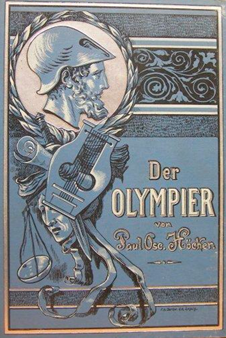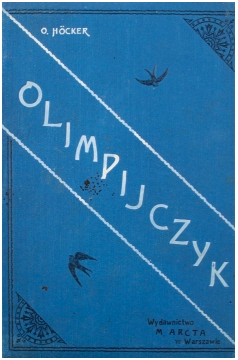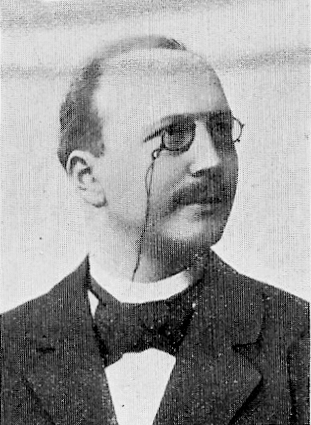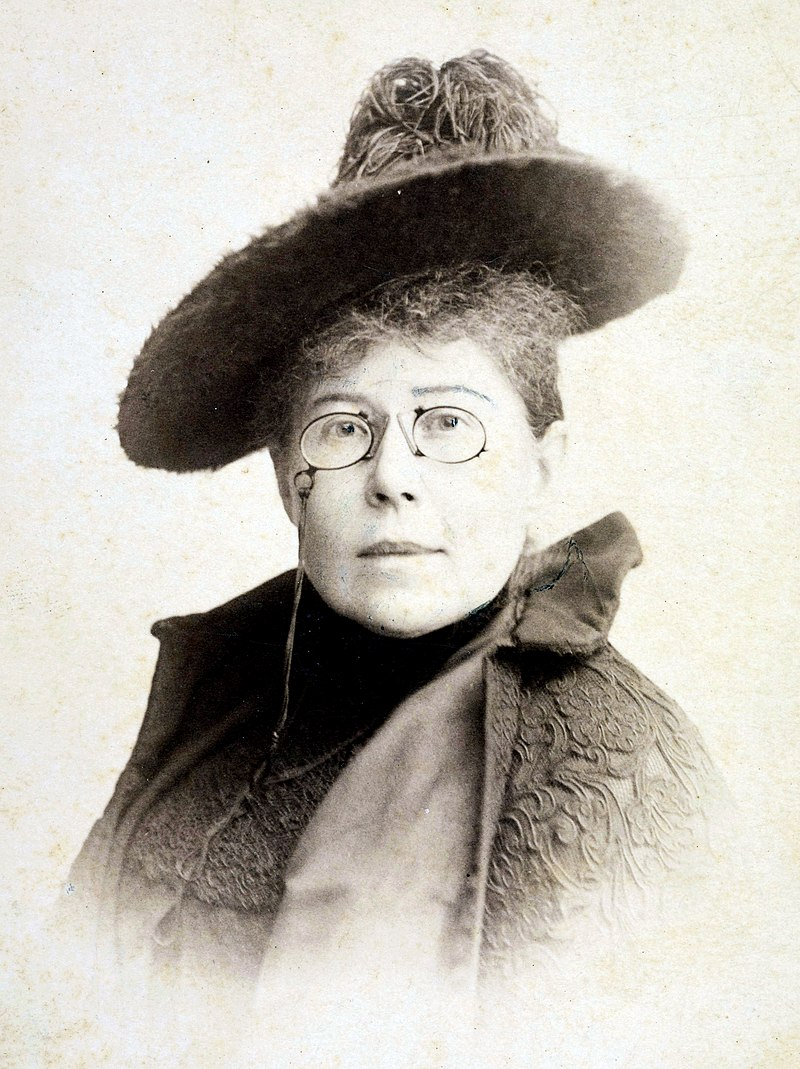Title of the work
Country of the First Edition
Country/countries of popularity
Original Language
First Edition Date
First Edition Details
Oskar Höcker (M. K. [Maria Konopnicka]), Olimpijczyk. Opowiadanie historyczne z czasów Peryklesa, podług Oskara Höckera napisała M. K. Warszawa: Nakładem Michała Arcta, 1900, 268 pp.
ISBN
Available Onllne
Source: Biblioteka Narodowa
Public domain, available at Polona (accessed: October 5, 2021).
Genre
Historical fiction
Target Audience
Children (teenagers, young adults)
Cover


Editiones principes : German, 1894, and Polish, 1900 (scans Marta Pszczolińska).
Author of the Entry:
Summary: Anna Ślezińska, Univeristy of Warsaw, annie_s@o2.pl
Analysis: Marta Pszczolińska, University of Warsaw, m.pszczolinska@al.uw.edu.pl
Peer-reviewer of the Entry:
Katarzyna Marciniak, University of Warsaw, kamar@al.uw.edu.pl
Elżbieta Olechowska, University of Warsaw, elzbieta.olechowska@gmail.com

Retrieved from Wikipedia (public domain).
Paul Oskar Höcker
[Heinz Grevenstett] , 1865 - 1944
(Author)
Paul Oskar Höcker (pen name Heinz Grevenstett) (1865–1944), originally from Meiningen, was a German writer and editor, author of children’s books, comedies, historical novels, crime novels and war memoirs. Though he studied composition at the Berliner Musikhochschule and even worked as a conductor, he decided to devote himself to writing. He was an editor of Velhagen & Klasings Monatshefte, where young authors were published. In 1914 he reported from the war for the Berliner Lokalanzeiger, Feldpostbriefe and was asked to establish and edit Liller Kriegszeitung. In the memoirs An der Spitze meiner Kompanie. Drei Monate Kriegserlebnisse (1914), Ein Liller Roman (1917) and Die Stadt in Ketten (1918), he described his experiences from the Great War. He became the author of many bestsellers for children and adult readers, some of which have been adapted to films. In 1933 he signed the German writers’ declaration Gelöbnis treuester Gefolgschaft, a pledge of loyalty to Nazi Germany and the Reich Chancellor Adolf Hitler. Thus, his autobiography Gottgesandte Wechselwinde. Lebenserinnerungen eines Fünfundsiebzigjährigen (1940) was banned after WW2 in the German Democratic Republic (DDR).
Source:
Schulz, Eckhard, “Höcker” in Neue Deutsche Biographie, vol. 9, Hess–Hüttig, Historische Kommission bei der Bayerischen Akademie der Wissenschaften, ed., Berlin: Duncker & Humblot, 1972, 305–306.
Filmography at IMDb (accessed: October 5, 2021).
“Novelist-Soldier’s Narrow Escapes” in The New York Times Feb. 7, 1915. (accessed: October 5, 2021).
Bio prepared by Marta Pszczolińska, University of Warsaw, m.pszczolinska@al.uw.edu.pl

Photograph retrieved from Wikipedia Commons.
Maria Konopnicka
, 1842 - 1910
(Author)
A poet, novelist, journalist, critic, translator, and one of the most beloved authors of books for children and youth. Her artistic writings were, first of all, an expression of deep patriotism and longing for Polish independence. She could also be considered an activist for women’s and children’s rights. She co-organized an international campaign against the persecution of Polish children in Września (1901–1902) under Prussian rule. In 1905–1907, she organized a campaign of assistance to Polish patriots jailed by the Russian authorities and their families in Warsaw.
Her most important works for children: Śpiewnik dla dzieci [Songbook for Children], 1890; Co słonko widziało [What Did the Little Sun See], 1889; Dym [Smoke], 1893; Nasza szkapa [Our Old Mare], 1893; O Janku Wędrowniczku [Johnny the Wanderer], 1893; O krasnoludkach i sierotce Marysi [The Dwarves and the Little Orphan Mary], 1896; Na jagody [Let’s Pick Blackberries], 1903; Szkolne przygody Pimpusia Sadełko [Fatty Puff’s School Adventures], 1905. Many of her books are compulsory reading for elementary schools. Especially famous is The Dwarfs and the Little Orphan Mary: every year, from spring to autumn, the dwarves work and help poor people such as Little Mary, who has lost her flock of geese. The value of work, the meaning of poverty and the beautiful Polish landscapes are the most frequent motives of Konopnicka’s publications.
Source:
Bielawski, Jerzy and Krzysztof Płociński, eds., Maria Konopnicka (1842–1910) (accessed: October 5, 2021).
Lorent-Umięcka, Krystyna and Emilia Jakubowska, Bibliografia twórczości Marii Konopnickiej dla dzieci i młodzieży, Warszawa: Wydawnictwa Uniwersytetu Warszawskiego, 1989.
Pierwsze wydania utworów Marii Konopnickiej – ze zbiorów suwalskiej biblioteki. Biblioteka Publiczna im. Marii Konopnickiej w Suwałkach. Dział Informacyjno-Bibliograficzny [Maria Konopnicka’s first editions – from the collection of Maria Konopnicka Public Library in Suwałki. Section of Information & Bibliography], Suwałki, 2010, 83.14.28.26/tekstydoc/konopnicka.doc (currently inaccessible).
Bio prepared by Anna Ślezińska, Univeristy of Warsaw, annie_s@o2.pl
Translation
Hebrew: Ben ha-Olimpus: sipur histori mi-yeme Periḳles, trans. Shelomoh Sḳulsḳi, Tel Aviv: ʻAmiḥai Publishing House, 1958.
Summary
Based on: Katarzyna Marciniak, Elżbieta Olechowska, Joanna Kłos, Michał Kucharski (eds.), Polish Literature for Children & Young Adults Inspired by Classical Antiquity: A Catalogue, Faculty of “Artes Liberales”, Warsaw: University of Warsaw, 2013, 444 pp.
The action takes place in the 5th century B.C., in Athens. Cimon’s military successes ensure the support of Athenian citizens; aristocracy remains in power in the city-state. Pericles keeps away from politics, but he is concerned about the situation. He participates in many discussions with scholars and other public figures, such as Anaxagoras, the philosopher, and Phidias, the sculptor. He falls in love with an Ionic woman, Aspasia, and marries her. After a military humiliation at the hands of the Spartans, Cimon is chased away from the city. Pericles gains recognition and assumes power. An anti-Athenian atmosphere sweeps across Greece. When Sparta attacks Athens, Pericles succeeds in obtaining a guarantee of peace for 30 years. Peace favours a rapid development, and the city becomes a centre of culture. However, with the support of other poleis, Sparta breaks the agreement before its term and attacks Athens. A plague breaks out in the city overcrowded with refugees. Faced with war and disease, Athenians withdraw their support for Pericles. Many of his friends are sued in court. Cleon gains power for a short time, but his incompetence makes Athenians clamour for Pericles’ return; he agrees to come back and delivers an uplifting speech but overwhelmed and exhausted, he dies during the night. Athenians mourn him.
Analysis
The story is set between 470 and 429 BC, a golden era for architecture and art in the period of Athenian glory. Konopnicka, in her preface, clearly reveals her goal. She lets the reader know that the novel is based on detailed research (ancient sources were used, especially Plutarch, but also Aristophanes, Athenaeus, Plato, Thucydides) so that the tribulations of characters could become an introduction to the life of the Attic society. The presence of historical figures, members of their families, friends, foes, etc., against the background of the cultural climate of Athens and Attica serves two functions – to entertain and teach young readers.
The plot is focused on Pericles, including his political, military, cultural activity and personal life. As the book served an educational goal, the facts from his private life as described by the ancient authors were modified to fit the composition and/or character traits given to the protagonists by the author. Thus the story of Pericles, described as a flawless statesman, patriot and great man, does not include the fact that he was told to divorce his first wife, with her family’s agreement, and to offer her a new husband. Instead, his wife (who died in the same year of the epidemic as Pericles and their sons) separates from her husband voluntarily. She dies in the second chapter leaving Pericles with two sons, Paralus and Xanthippus, and the step-son Callias, who, instead of mourning his mother, is happy to inherit her properties. Additionally, Pericles’ long relationship with Aspasia (whose actual marital status is still in some doubt) is presented as a legal union and Aspasia herself as a wise, mature intellectual and a pure, warm, tolerant and caring woman, an ideal partner of her elder husband. Probably, nineteenth-century morality prevented any mention of the ancient reports of her scandalous life as a possible hetaera or courtesan or of the illegitimate child the couple had. Thus, the ethical model for the young reader is clear: a just man, an unusual historical figure, with an extraordinary wife suitable for his high standards. To add to Pericles’ greatness as head of the family, he brings up, single-handed, his two sons, a step-son, and Alcibiades. Despite his lack of success in the moral education of the abominable Callias and Xanthippus, he remains a great father, understanding, forgiving and patient. Similarly, the ten-talent bribe given to Sparta for withdrawing troupes from Attica is presented as a result of deep patriotism, wisdom and pacifism combined to protect Athens and allow the city to develop in peace and wellbeing.
The plot is just a pretext to show the rich ancient background, full of information on Athenian topography, buildings, artistic masterpieces, historical facts, warfare, the state structure, fractional politics, rhetoric, philosophical thoughts, intellectual circles, Dionysian theatre performances, customs, feasts, the social status of women or slaves and so on. Curiously, the rehearsal of The Eumenides becomes the scene of political murder. From that point, the text of the last play of Oresteia terrifies Xanthippus; being responsible for a death, he feels chased by Erinyes. The chapter set in Elis provides a look at ancient Olympia during the time of the games. The logistics of competing in various disciplines are described (Xanthippus is a contestant and Pericles is chosen as a judge), and the newly sculpted statue of Zeus – one of the Seven Wonders of the Ancient World – inspired by Homeric verses. In a short scene at Olympia, Phidias himself cites Homer to admirers of his talent and skills.
Further Reading
Azoulay, Vincent, Pericles of Athens, Princeton University Press, 2014.
Henry, Madeleine M., Prisoner of History. Aspasia of Miletus and her Biographical Tradition, Oxford: Oxford University Press, 1995.
Plutarch, Plutarch's Lives with an English Translation by Bernadotte Perrin, Cambridge, MA: Harvard University Press, London: William Heinemann Ltd., 1916. 3.
English: Perseus Digital Library (accessed: October 5, 2021).
Greek: Perseus Digital Library (accessed: October 5, 2021).
Thucydides, History of the Peloponnesian War,
trans. Thomas Hobbes (1628) (accessed: October 5, 2021).
trans. William Smith (1753) (accessed: October 5, 2021).
trans. Richard Crawley (1874) (accessed: October 5, 2021).
trans. Rex Warner (1954) (accessed: October 5, 2021).
Tracy, Stephen V., Pericles: A Sourcebook and Reader, University of California Press, 2009.
Addenda
The book is an adaptation of Höcker, Paul Oskar, Der Olympier. Kulturgeschichtliche Erzählung aus dem Zeitalter des Perikles Der reiferen Jugend gewidmet. Mit zehn Illustrationen von Felix Schmidt, Leipzig: Geibel & Brockhaus, 1894.
The book was also published as: O. Höcker, Złoty wiek Peryklesa (Olimpijczyk). Opowiadanie historyczne podług Oskara Höckera napisała Marja Konopnicka, Warszawa: M. Arct, 1922 (accessed October 5, 2021), 1923 (accessed: October 5, 2021).


